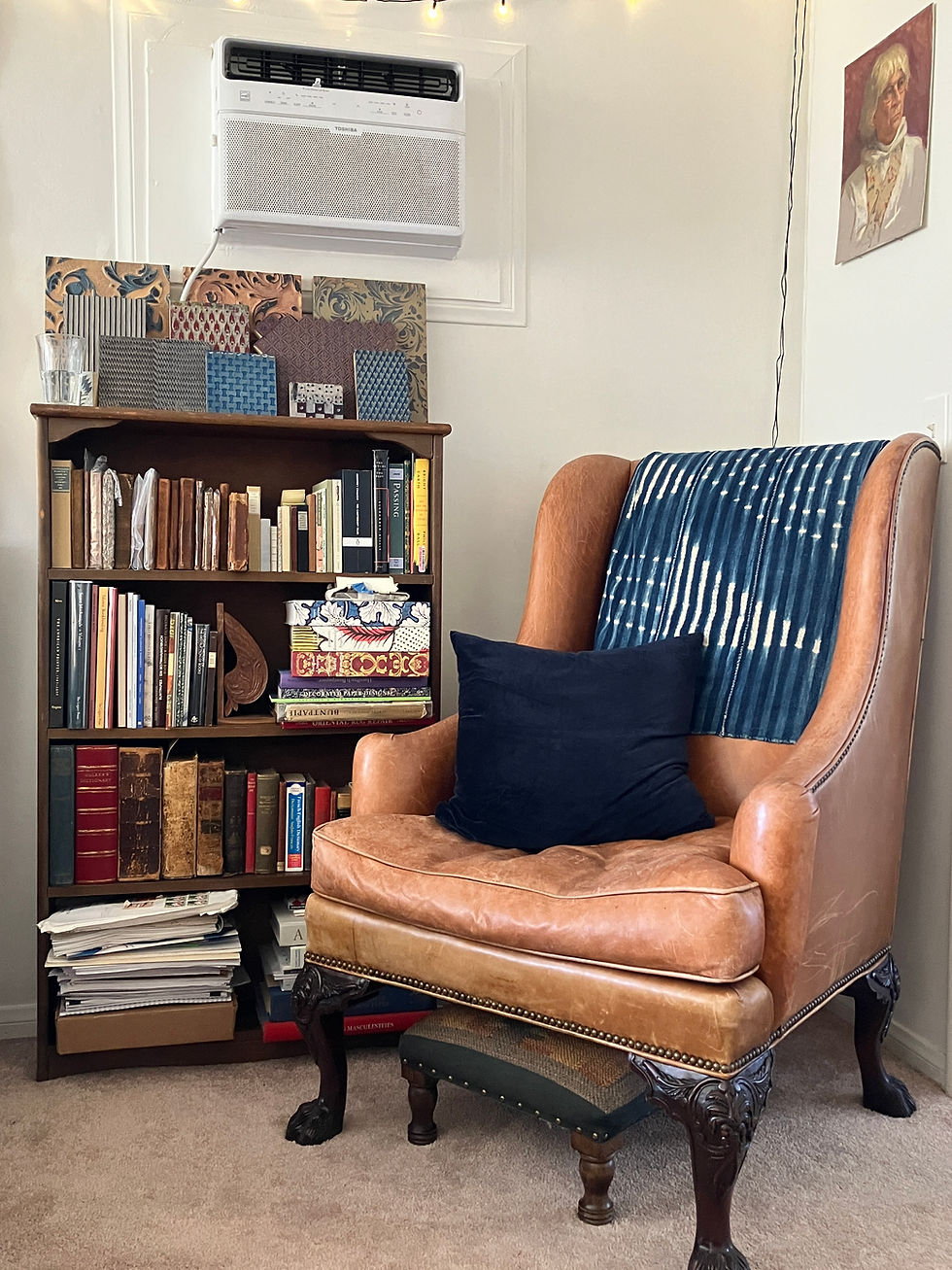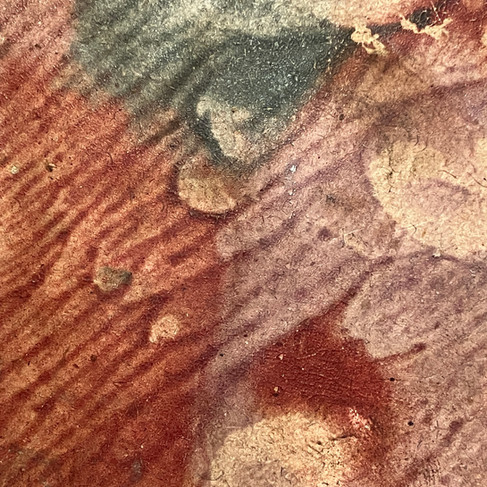Celebrating #200!
- Mitch Gundrum
- Jul 8
- 6 min read
Updated: Jul 15
The first book I ever bought explicitly for its decorated paper, the seed from which this entire collection has grown, was 19.060, an 1870 quarter leather binding with green and black achatmarmor covering paper. It was purchased on October 6, 2019, from the discount carts outside of Brattle Book Shop in Boston for $3.25. I had just started studying in the bookbinding program at North Bennet Street School, and could not have had any idea about the extraordinary ride that would unfold in months and years to follow.
Up until very recently, I occasionally shared new acquisitions, milestones, and discoveries from my decorated paper collection via Instagram, but was always dissatisfied with the ephemerality of the social media stream. In January 2025 I finally launched this digital catalog with photographs and bibliographic descriptions of every item in the collection under the banner 'Schweben Buntpapier'. Today, I introduce this new blog to mark the collection's 200th addition. Officially, that title goes to 25.065, a full paper lapped component binding with a charming three-color blockprinted paper covering. If it was the first decorated paper book I ever laid eyes on I'd still be delighted, but as a culmination of almost six years of targeted collecting, and in the context of so many other papers which highlight its unique character, it is worth more than it ever could on its own. That's the motivation behind this collection and this catalog, and I'm delighted to share some insights from the current state of that effort.

As of July 8th, 2025, Schweben Buntpapier consists of 212 decorated papers and paper bindings, including 50 wrappers, 50 full paper (over boards) bindings, 65 bindings with tanned leather and decorated paper coverings and/or endpapers, 14 limp-paper bindings, and 7 boxes. As a matter of economy, I tend to prioritize acquisitions which include multiple papers (covering and endpapers, bindings with slipcases, etc.), so some items fall into multiple categories. The scaleboard bindings (13), for example, are mostly quarter leather bindings with either vat-dyed, surface-colored, marbled, blockprinted, or paste paper board coverings, but one example includes a blockprinted overcover (20.039). The title for the greatest number of distinct papers on a single item goes to 25.037, which includes 2 blockprinted and 1 sponged paper used on the leather pull-off case, and another blockprinted design for the endpapers. On the other extreme, the collection also includes two completely plain laced limp paper bindings (25.003 and 24.096).
Tallied against the geographic data for associated imprints, some interesting preliminary trends take shape. Germany is by far the best represented in the collection overall (82 examples), trailed by Italian (29), French (20) and American (19). These, of course, are not necessarily attribution for the bindings or papers used on these imprints, as a single title or imprint could be printed, traded, bound, and sold in several different countries. That being said:
While German imprints dominate overall, they're notably less present in wrapper bindings (only 5 examples), where instead Dutch, Italian, and French imprints prevail.
11/14 (79%) limp paper bindings hold Italian imprints
6 of the 8 quarter cloth bindings hold American imprints dating 1836-1846; a seventh example (24.061) dates earlier but was likely rebound. Of the 16 quarter leather bindings, half of these are also American publications.
The below list shows the breakdown of publication cities represented in the collection. While I've noted some genres and publishers showing an apparent penchant for decorated papers (which are helpful for keyword searches!), the significance of these associations calls for scrutiny.

The most strongly represented style of decoration is blockprinting, for which there are 118 distinct items, followed by paste decoration (56), all-over surface coloring (27), and sprinkling (16). Several items include multiple papers or styles of decoration. German imprints account for 57% (32) of all paste-decorated papers. 23/29 Italian publications (79%) feature blockprinted paper, though of course these papers are being pre-selected. Of the 13 glazed paper examples in the collection, 8 are associated with German imprints.
Examples of different decoration styles: blockprinted, paste-decorated, surface-colored, and sprinkled.
The breakdown of colors used in the papers is shown below. So far, these numbers are agnostic of time period, specific colorant, and more granular subcategorizations (e.g. cerulean vs. indigo), but these are threads I hope to pursue in the future for whatever hints they might reveal. I have also made note of several 19th century green-colored bindings which were analyzed with X-ray fluorescence spectrometry and included my elemental identifications in the Notes section of their catalog entries.

The explicit focus of this collection is papers from the "long 18th century", which I've defined as approximately 1670-1830. I have found, however, that I'm particularly drawn to papers from the 1790s, and these are well represented in the collection. Out of 212 objects, about 56% (118) contain imprints dating from the 18th century and 43% (90) date from the 19th century, with a steep drop-off after 1840. Just 4 items bear publication dates from the 17th century, and of these only the paste-colored account book wrapper from 1656 (25.055) is likely contemporary, with 18th-century papers covering the others (20.041, 24.067, 25.072). These latter books are easy to find in the catalog as it's sorted chronologically by default—I'm working on implementing additional sorting capabilities, and would love to hear what folks would find useful. The breakdown by decade of publication date is shown below.

Thus, while the collection can be said to focus on 18th-century German and Italian decorated papers and paper bindings, there are a few items which set themselves apart from this broad stroke:
Finally, if you're wondering—as I did—how a regular person could ever afford to collect centuries-old books, it's worth noting that the average cost per book across the entire Schweben Buntpapier collection is $55.95, and most were purchased significantly cheaper (121 items for $50 or less!). I enjoy the pursuit and discovery of these papers just as much as the acquisition, which means I'm willing to wait for deals to pop up, or to hold a special item in my wishlist for months or years to save up for it as a treat. Patience is key, along with having a mission statement for your collection, a guiding principal that ensures what you're buying is a contribution toward your ultimate goal. My collection came to me one, two, or a few objects at a time, and I'm really all the more proud of it for that reason—the books are things I bought, but the collection is something I built.
~~~~~~~~~~~~~~~~~~~~~~~~~~~~~~~~~~~~~~~~~~~~~
Where will we go from here? In between my other research interests, I continue to add to my reference library, seeking out new attributions and associations for particular patterns and styles which are regularly added to the catalog as they're discovered. I'd love to facilitate some kind of ArcGIS-esque mapping capability based on publication data for a visual reference of where these objects are coming from. Similarly, I'm working on a reference timeline for decorated paper styles which will hopefully aid in visual identification. Website functionality is a priority, including enhanced filtering and tagging for additional binding styles, decoration types, and associations between these. On the backend, I'm building new tables and trying to find relationships between the elements I've already captured, and it's exciting to see those trends shift and develop as more books are added to the data set. My perennial task, then, and perhaps even the end to which all of this data-crumbling is merely a means, is "just more books".











Comments